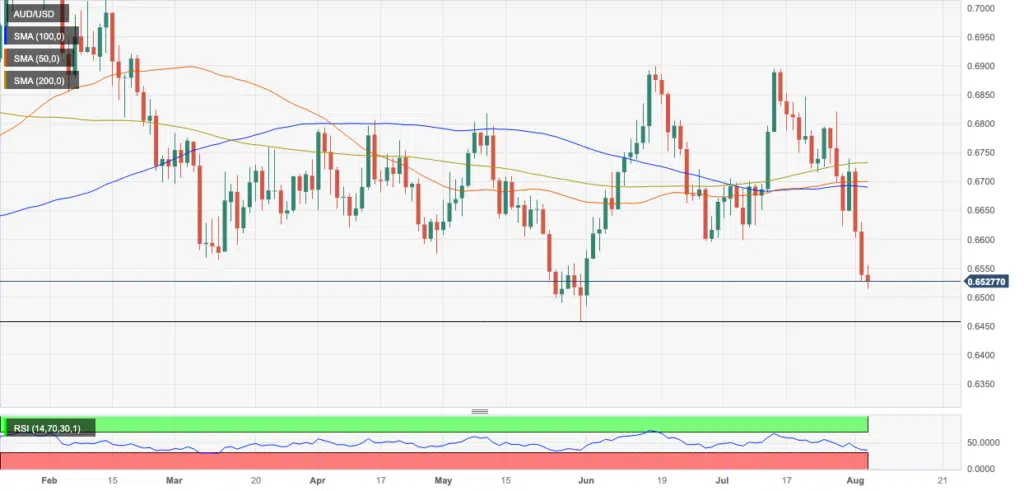The AUD experiences a brief respite against the USD on Thursday, following intense downward pressure. Data reveals that Australia’s trade surplus in June surpassed expectations, reaching $11,321 million. This positive outcome played a role in stabilizing the situation. Additionally, the Caixin Chinese Services PMIs for July were pleasantly surprised with a reading of 54.1.
During the US session, the AUD/USD pair is observed to be trading within the range of 0.65s.
Recent Events and Developments Involving the Australian Dollar
- Following the publication of the Australian Trade Balance numbers for June, the Australian Dollar eventually returned to its previous level after initially falling during the early part of Thursday’s trading session. The data comes in higher than the 11,000M that was projected, registering a print of $11,321M instead. The sum is more significant than the $10,497,000,000 reported in May.
- The China Caixen Services PMI for July surpasses the projected value of 52.5, registering a reading of 54.1, compared to the previous month’s figure of 53.9. As Australia’s largest trading partner, this development brings positive implications for the Australian economy.
- Despite the recent reduction of US debt from AAA to AA+ by credit rating agency Fitch on Monday, the value of the US Dollar has continued its upward pace. Eren Sengezer, the lead analyst at FXStreet, believes that the predominant gloomy feeling in the market is to blame for the recent surge in the value of the Dollar, even though the Dollar’s rating has been reduced. Because of this mentality, safe-haven currencies like the US dollar are in demand.
- ADP, a company that processes payroll for the private sector in the United States, released some statistics on Wednesday that gave extra support for the Dollar. The figures suggested that 324 thousand new employees were added to the labor force in July, which was far more than the growth of 189 thousand that economists had predicted. Despite this, it is essential to note that this number is still lower than the 497K reported in June.
- The US Department of Labour reported that the Initial Jobless Claims for the US stood at 227K, meeting expectations. This development had a dampening effect on the USD’s upward momentum and contributed to the decline of the Aussie.
- The Australian Dollar exhibited weakness following the RBA’s decision to maintain the policy rate at 4.1% on Tuesday morning, contrary to market expectations of a 25 basis points increase. The policy statement elucidated that the RBA’s choice to maintain rates at their current level would allow for a prolonged evaluation of the consequences of previous policy adjustments and the overall economic trajectory.
- About the matter, the potential for additional rate hikes in the future was not entirely dismissed. The RBA acknowledged that there might be a need for some further adjustments in monetary policy to facilitate the return of inflation to the desired target within a reasonable timeframe. However, the decision on whether to proceed with such measures will be contingent upon the available data and the ongoing evaluation of associated risks, as stated by the RBA.
The Technical Analysis of the Australian Dollar
When examining the AUD/USD pair on a longer-term weekly chart, it can be observed that it is currently displaying a predominantly sideways trend, despite its short-term bearish bias. The level reached in February, specifically at 0.7158, is a notable resistance point. A breakthrough at this level could shift the overall perspective towards a more optimistic long-term outlook.
Similarly, on the flip side, the low of 0.6458 recorded in June holds significant importance for those with a bearish outlook. A clear breach of this level would contribute to a more pessimistic tone on the chart. The current price is experiencing a downward movement near the mentioned critical low.

The price has forcefully broken through the MA close to 0.6700. At this crucial confluence, the simple moving averages of the last 50 weeks, the previous 50 days, and the last 100 days all converge. When a significant support or resistance level is broken, a negative emotion is triggered in the market.

A Measured Move pattern or a three-wave ABC corrective would have been completed by July’s close (as seen on the daily chart). This would be one of the conceivable outcomes of this scenario. If such a scenario plays out, an immediate short-term upcycle will likely occur as a result. When considering the recent adverse price action, it is essential to point out that the possibility of this specific scenario becoming a reality constantly decreases as time passes.
The AUD/USD pair has recently broken through the intraday lows for June, which occurred at 0.6600, potentially opening the way for a further slide toward the major lows for May, which happened at 0.6460. The possibility of a break beneath those levels might open the door for a negative trajectory that leads to 0.6170 and the lows seen in 2022.
An extended candlestick on a daily chart that neatly overcomes the critical level in question and closes around the day’s high or low point is referred to as a “decisive break” in the parlance of the financial markets. This term comes from the realm of technical analysis. It may also signify a sequence of three consecutive upward or downward movements that neatly transcend the predetermined threshold, with the closing price of the last day being relatively close to its extreme and a substantial distance from the point.


